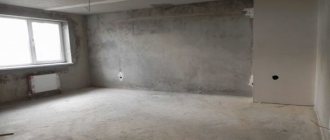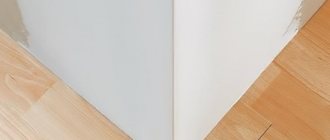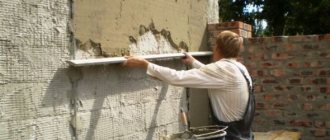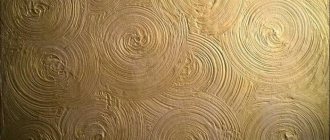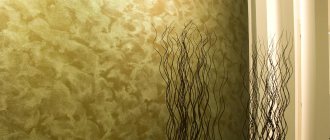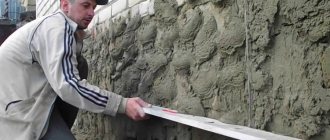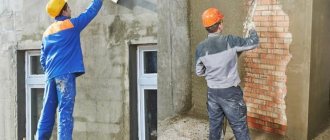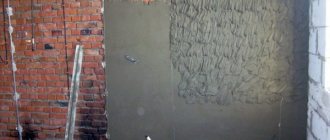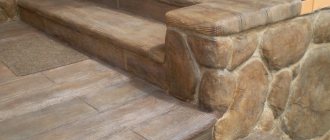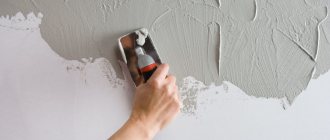Hello readers of my blog! Today we will talk about how to plaster walls with cement mortar with your own hands. It would seem that the matter is not tricky, but when you are faced with this problem, you have to think about how to do it correctly, what preparation to do, what materials to choose. Thus, I decided that this article would be useful to someone, and I am devoting my efforts to this subject. In it, I will answer a number of questions that will arise immediately before How to plaster walls with cement mortar with your own hands, and some even after that. This topic is quite broad, because before work, thorough preparation is necessary, but how to do this? And this is a separate topic. You can learn about all this in great detail in the article below. How to plaster walls with cement mortar with your own hands
Plastering is a process that improves the quality of the treated coating and increases consumer properties accordingly. Thanks to today's material, you will learn how to mix mortar for plastering walls with your own hands.
All proportions are given separately from the cooking technology. We will also consider a list of ready-made mixtures suitable for people without experience in such matters. Please share your feedback in the comments.
Ready-made mixtures for preparing mortar for plastering walls
For those who don’t want to bother, we advise you to purchase a ready-made composition. The manufacturer indicates on the packaging its recommendations for diluting the solution. You won't have any difficulties.
No. 1. "Knauf Diamant"
Price – 340 rubles.
Decorative plaster, which is a colored mixture based on cement. The filler is quartz sand. The advantages include excellent water-repellent characteristics, as well as immunity to temperature changes and ultraviolet radiation.
It is used both for the facade and for finishing walls inside the house. The proportions are such that for 25 kg. the mixture is supposed to be 7.5 liters.
water. The prepared solution must be used within 2 hours maximum. Packaging in 25 kg bags.
№2. «UNIS»
Price – 280 rubles.
An excellent option for finishing a room inside or outside. Among the advantages, we highlight the absence of shrinkage, resistance to moisture, pressure and temperature changes. The composition is distributed over the walls in a layer of 3 cm, and there is no need for reinforcement.
You can make your own mortar for plastering walls, but it makes sense to purchase this mixture. The breeding proportions are as follows: per 10 kg. composition is supposed to be 1.6-2 liters.
water. The solution must be used up within 2 hours. Packaging is carried out in 25 kg bags.
No. 3. "Prospectors"
Price – 190 rubles. Cheap composition for further dilution of the solution. It is made on the basis of cement, the final coating is strong.
After distribution, the mixture does not shrink and there is no risk of cracks. As for the proportions, for 10 kg. dry composition accounts for 2.6-2.8 liters.
water. After mixing, the solution must be used within 1.5-2 hours. Packaged in 25 kg bags.
No. 4. " Weber Vetonit "
Price – 360 rubles.
Premium composition, cement plaster. Among the obvious advantages, it is worth highlighting the absence of shrinkage, the strength of the final coating, ease of application, resistance to moisture and temperature changes, as well as the plasticity and quality of the product. When breeding, you should be guided by the proportions: per 10 kg. dry composition accounts for 2.5 liters. water. The solution must be applied within 3 hours, it will dry for 2-6 days.
No. 5. "Osnovit Flywell T-24"
Price – 240 rubles. If you need a cement-based solution for plastering walls, there is no point in making it yourself.
Consider this option. Pros: ease of application, resistance to moisture, frost and temperature changes. Proportions: for 10 kg.
dry mixture accounts for 3-4 liters. water. On the shelves of construction supermarkets you will find them distributed in 25 kg bags.
Beacons for plaster
What is a lighthouse? As you know, a lighthouse is a landmark for something. Such guidelines during plastering of the wall can be any hard marks that are set according to the level.
The beacons can be based on boards, nails, or dried mortar tubercles applied to the wall. But the best are perforated metal profiles, which in construction stores are called beacons. They can have different thicknesses. It all depends on what layer needs to be plastered. In addition, it should be taken into account that the thicker the beacon, the tougher it is.
Installation methods
First way. Dots are applied to the surface of the wall using a mortar of cement, tile adhesive or putty. A perforated metal beacon is glued to each point and then leveled using a building level. It should be noted that a short level is inconvenient for proper plastering (deflections occur in places of pressure). But don’t despair if you only have a short level available. First, a rule is applied to the beacons (without it it is impossible to plaster, so it must be at hand). Then the building level is applied to the rule.
Second way. Using a hammer drill, holes with a diameter of 10 mm or more are drilled strictly along a vertical line. The holes are filled with wooden choppers; it is better to make them cone-shaped so that the lighthouse profile can be attached to them more easily. Using a cord or fishing line, each row of choppers is leveled. You can trim the row along the marking thread using a hammer or a hacksaw. The beacons are attached to the already leveled chopiks using screws 2.5 cm long. The gaps between the chopiks are filled with a solution based on cement and sand. This is done to ensure that the rule does not bend under pressure. This method of placing beacons is used for very uneven walls with large differences. The first method is not suitable, since the layer of plaster will not stick.
The length of the rule used for work must be at least 10 cm greater than the distance between the beacon profiles.
When choosing the first method of installing beacons, you must first let them dry and only then start plastering.
Self-preparation of the solution - proportions
If you don’t have the funds to purchase a special mixture, you can make it yourself. We will present the proportions for lime and cement mortars, and below we will consider the mixing technology.
No. 1. Mortar
Before you make a lime mortar that is ideal for plaster, study the proportions:
No. 2. Cement mortar
Since you can prepare a mortar for plastering walls from cement and sand, we present the ratio. The finished composition is distributed over the walls in three layers, each of them having its own proportions:
Advantages and disadvantages of plaster
If you compare lime plaster, it will have its pros and cons.
Among the advantages are:
- has high adhesion not only to mineral surfaces, but also to wood;
- unlike gypsum and cement mixtures, this composition is elastic after drying, which reduces the likelihood of cracks;
- a lime wall breathes and regulates room humidity, which reduces dampness in rooms with high humidity;
- low cost;
- very favorable consumption compared to cement mortars;
- long operating time and survivability of the mixture;
- plasticity, which simplifies application and alignment;
- Fungus or mold never appears in lime.
Despite such a large number of advantages, lime plaster also has disadvantages:
- relatively low strength, especially compared to the cement composition;
- requires working only in a respirator and gloves;
- the need to create special conditions for drying the plaster or adding additives to the solution;
- requires a special approach when mixing with water.
These disadvantages, in particular, have contributed to the fact that today pure lime plaster is rarely used.
Elasticity is one of the advantages of lime plaster
Self-preparation technology
Now that we’ve figured out the ratio, let’s study the technology for mixing lime and cement mortars.
No. 1. Mortar
1. The composition is prepared long before the intended plastering of the walls. Take care of this 2-4 weeks in advance. If lime is properly slaked, it will be stored for a long time without loss of quality.
2. Do-it-yourself mortar for plastering walls is made after preparing the appropriate utensils. You have studied the proportions, now take a non-rusty metal container; plastic containers are not used.
Quicklime is considered a toxic component, so make sure you have a mask and gloves in advance. Take care of your mucous membranes and skin to avoid burns.
3. Pour lump lime into a basin (1 part), pour in cool water (2 parts).
Mix the contents with a stick or shovel. This will speed up the hydration process. The duration of extinguishing can take up to half an hour.
Everything will depend on the composition of the lime. As soon as the steam release decreases, stir everything again. Repeat several times.
4. When the reaction is completely complete, stir the grounds one last time.
Cover the container and leave for 12-14 days. Over the allotted time, the mass will become plastic. In addition, all lumps will disappear.
5. If you are going to carry out work on a large scale, you will have to dig a pit of at least 1 m.
in depth. Lime is poured into the hole. Next, you need to water it with water from a hose.
As soon as the chemical reaction stops, an impressive layer of sand is poured in (in accordance with the proportions above). The pit must be covered with a wooden shield. After 2-4 weeks, the composition can be used for its intended purpose.
The solution for plastering walls is quite simple to make. It is enough to mix all the components with your own hands and wait the specified period. If you follow the proportions, you will end up with an elastic dough.
Working as a rule
Applying the rule to the installed beacons, it is pulled along the solution, starting from the bottom and moving up. When moving the rule, they perform simple movements - sharply pull from left to right, and then in the opposite direction. These manipulations are carried out until the entire mortar on the sketched area is completely leveled.
Then a new section is sketched and again leveled using the rule. Irregularities and resulting grooves are eliminated using a trowel. The mortar is placed on the tip of the trowel and then thrown. All this is again corrected by the rule.
Cement mortar
To finish the facade or walls in a room, you can use cement mortar. The plaster will be applied in 3 layers. Let's look at everything in order.
Layer No. 1 – spray
1. Before preparing the cement mortar, you should know that the first layer will be a little liquid. This is necessary for plastering walls using this technology.
The layer thickness should not exceed 4 mm. You will need 25 kg. cement grade M500.
2. Prepare a container of sufficient size and pour 6 buckets of sand into it (bucket volume 10 liters). Don't forget to sift it first. After this, add cement and mix everything thoroughly with a shovel.
3. Next, 15 liters are poured. water.
Mix the ingredients vigorously. If necessary, break up any lumps. As a result, you should get a homogeneous mass.
4. Finally, pour in another 10 liters. water and stir the grounds thoroughly. Next you can apply plaster.
Layer No. 2 – ground
1.If you have made a cement mortar for plastering the walls and sprayed it yourself, proceed to the next step. Keep in mind that the second layer is distributed immediately after the first one has set. The cement mortar must not be allowed to harden completely.
2. When preparing the primer layer, observe all proportions.
When applied, its thickness should not be more than 15 mm. When performing work, there is no need to use mesh for reinforcement. The second layer should be made of a mixture with a structure like stiff dough.
3. Pour 25 kg into a container.
cement, keep in mind that you need to add 15 ml to each bucket. liquid soap. Next, add 5 buckets of sand (sift in advance).
There will be enough water in quantities of up to 20 liters. Mix all ingredients in the same order as described. Apply.
Layer No. 3 – covering
1.To make the final layer, you need to purchase the finest sand. In addition, it must be as clean as possible. The thickness of the final layer should not be more than 3 mm.
2. It is recommended to add lime paste to the final layer. As a result, the surface is much easier to rub, and it does not shrink.
3. If you use a concrete mixer, the mixing process is slightly different from manual mixing.
Pour about 17 liters into the device’s container. water (total 25 liters required). After this, fill the bag of cement.
4. The mixture is kneaded for about 3 minutes. Next add 100 kg.
sand and add the remaining water. Mix the ingredients for about 5 more minutes. If you decide to add lime paste, it must be mixed together with cement in an amount of 55 liters.
It is easy to understand that preparing a solution for plastering walls is quite simple.
If you need large volumes, it is better to use a concrete mixer. In other cases, you can handle the task yourself. Don't forget to respect all proportions.
Plastering walls with cement mortar
Apartment renovation includes a whole range of work aimed at leveling the surfaces of walls and ceilings. It is no secret that most Soviet-built buildings do not have perfectly straight walls.
In order to eliminate this defect, the installation of plasterboard panels or lining can be used, however, these methods are associated with the appearance of voids in the walls, as well as a significant reduction in the usable area of the rooms.
To avoid such shortcomings, you can use plaster. This is the oldest and at the same time the most popular method of leveling walls. In turn, of all possible materials for plastering, cement mortar has been the most widely used for many years.
This is not surprising if you take into account the following advantages:
Strength.
A high-quality mortar applied to the wall in compliance with all technological features of the plastering process can last for many years. The mortar is easy to manufacture and apply. If you have certain qualities, such as accuracy and attentiveness, as well as a clear knowledge of the sequence of actions, anyone can cope with this. Low cost. Today, cement mortar is perhaps the cheapest material for plastering walls.
Despite such wonderful advantages, it is possible to perform high-quality plastering of walls with your own hands in the absence of relevant experience only by showing maximum diligence and first familiarizing yourself with the peculiarities of carrying out such work.
The procedure for plastering walls with cement mortar includes four main stages:
Formulation options
You can prepare the plaster solution yourself. Even experienced craftsmen often improve the plaster formula, saturating it, for example, with PVA glue as a plasticizer. You can consider several common recipes for making plaster mortar yourself.
Putty based
To mix the bulk you will need ordinary putty (6 kg), water (2 l) and PVA glue (0.2 l). Dry powdered putty is placed in a container, water is gradually poured in, and stirred. Then add PVA glue and mix again. In the absence of such glue, it can be replaced with drywall grout (the proportions remain the same 1: 1).
With primer
The base remains putty, to which, instead of water, a primer is added in a ratio of 6: 2. The mixture is mixed, after which grout (0.2 l) and color are added to the mass (the saturation is selected individually). This recipe allows you to obtain decorative plaster material. Therefore, the primer must be used white in order to paint it without losing the quality of the desired shade.
Cement
To make such a plaster mortar you need cement, as well as sand and water. The ratio varies: for spraying the proportions are 1: 4, for soil 1: 3, water is added until the consistency of sour cream. The solution should not spread. You cannot use cement with sand in a ratio of 1:16, the sand coating will quickly crack.
Clay
Making clay plaster yourself is not difficult. The composition is made up of clay and sand; water is added to it for performance. Depending on the type of work, the proportions can be 1: 3, 1: 4, 1: 5. This applies to spray and soil. If clay-lime plaster is required for work, the proportions are as follows: lime 1 part, clay 2 parts, sifted sand 6 parts. If you need to plaster the walls outside, use clay, sand and cement in the ratio: 0.2: 3: 1, don't forget to add clean water.
With lime
Lime composition is used for finishing adobe houses. The coating is not durable and is afraid of moisture. Consists of slaked lime (1 tsp) and sand (3 tsp). For soil the proportions are 1:2, for spraying 1:3, for covering the ratio is 1:2. The lime-cement composition is more in demand. However, for kneading they use lime itself, and lime dough. The ratio of cement - lime - sand is different for each layer. For one layer it is 1: 0.4: 3 (4), for the second 1.61: 2.5 (3), for the third 1: 1.5: 4.
Plaster
The recipe for gypsum plaster involves the use of white gypsum powder. Six parts of the mixture will need to be diluted with 2 liters of cool water, then add 0.2 liters of PVA glue to it. If it is made with an admixture of lime, use lime paste in a gypsum-lime ratio of 1:3.
Venetian
This decorative plaster is prepared from ordinary fine-grained putty. Quartz, marble, malachite chips, slaked lime and color of the desired shade are added to it. The color concentration is selected individually, however, its abundance will lead to a deterioration in the quality of the solution. The total amount of lime for the entire composition varies between 50-60%! (MISSING) This takes 3 hours, while plaster takes 1 hour. To add gloss, after the coating has dried, it is treated with special wax.
Versailles
This finishing mixture for interior work is created on the basis of two types of putties: starting and finishing in a 1: 1 ratio. They are mixed and the desired color is added. An essential component that provides Versailles plaster with a special effect is silver. It is used after the coating has completely dried. Add to water-soluble varnish (dilute by half) and spray only the protruding parts of the relief.
Preparing the walls
The first stage of preparing a wall for plastering, which follows immediately after removing furniture from the room, is to remove a layer of old plaster or paint. This is a rather labor-intensive process for which a hammer drill or a hammer with a chisel is used.
To increase the efficiency of removing old paint (the most problematic type of coating in this regard), they resort to the use of special grinding machines. For home repairs, it may be worth renting such a tool for a short period of time.
If, during the process of removing a layer of old plaster, significant cracks or recesses were discovered in the wall, they must be repaired using a small amount of cement mortar and a special reinforcing mesh.
If the wall being treated is not monolithic, but is made of bricks or blocks, then all its seams must be deepened for better fastening of the plaster. Shallow notches are applied to the concrete wall using a hammer drill or chisel for this purpose.
The next stage of preparatory work is to apply a primer to the walls using a paint brush.
Depending on the material from which the wall is made, the process of preparing it for plastering may differ slightly. In general, to ensure reliable adhesion of the cement mortar to the wall surface, it is necessary to use a plaster mesh or tile adhesive applied with a notched trowel.
If you use glue, then after applying it you need to wait at least a day. This is done to give the glue a chance to dry. It should be noted that this method is not suitable for plastering large area walls.
Preliminary work for walls made of foam block, cinder block or shell rock can simply consist of generously wetting them with water.
However, the use of reinforcing mesh can significantly increase the strength of the plaster, prevent it from cracking during the drying process and significantly increase its service life.
If there is no factory-made mesh, homemade plaster reinforcement is sometimes used. To do this, using quick installation, aluminum wire is fixed to the walls.
The mesh used in plastering work is an elastic metal product that is attached close to the wall using dowels driven into it in advance.
In this case, the attachment points should be placed at a distance of 30 to 40 cm from each other in a checkerboard pattern. When purchasing reinforcing mesh for plaster, it is preferable to choose those types that have an anti-corrosion coating. Otherwise, you will have to cover such a product yourself with a layer of primer or paint.
After making sure that the installed mesh is firmly attached to the wall, you can begin installing guide beacons, which are usually used as a perforated corner of varying thickness (depending on the thickness of the plaster layer).
Guide beacons can be attached to the wall in one of the following ways:
Using screws. This fastening method is somewhat more labor-intensive; as a rule, it is used if it is necessary to eliminate significant level differences in the plane of the wall. In order to secure the screw, wooden strips protruding from the wall are hammered into pre-drilled holes with a hammer drill.
After this, marks are applied to them corresponding to the required level. The patches are cut according to these marks, and then a beacon is mounted on them. In order to prevent the corner from bending when applying plaster, you need to place a certain amount of cement mixture in advance in the openings between adjacent fastening points.
To properly secure each beacon by level, you can use guides made of fishing line or thin rope.
First, using a plumb line, the correct position of two threads, fixed vertically at different ends of the wall, is set. After this, focusing on them, using a level, pull the horizontal threads. This system greatly simplifies the process of installing beacons.
Which one is better to choose?
Cement plaster can be used for interior and exterior work. Experience in construction work shows that cement-based plaster is suitable for the listed work.
For interior work
TsPS plaster can be used for making ceilings and walls. It can also serve for decoration and can act as an intermediate coating. The contents of the composition are responsible for the duration of operation and strength.
Before laying cement plaster for interior work, you will need to assess the state of the microclimate in the room being treated. If it is dry, then it is advisable to use a lime composition. If the microclimate is normal, then it is reasonable to use cement-sand mortar or cement-lime mortar.
Cement composition. Gn is characterized by a long-term strength gain. Until this moment, 12 hours pass. For preparation you will need cement, sand, water; it is permissible to use additives that affect the properties of the cement plaster mixture.
The content of the cement composition looks like this - for the primer composition you will need one part of the binder, two or three parts of the aggregate.
For exterior decoration
Cement-lime plaster is often used for the external coating of a building. This material is often chosen because it adheres well to almost any material used to create the surface.
To obtain a high-quality composition, you first need to prepare a dry mixture, this will require 1 part cement and 5 parts sand, the volume of sand can be changed depending on the requirements for the thickness of the solution. This material must be of high quality, because it depends on how well the work is carried out.
For the most part, grade 400 cement is used to prepare this solution. By the way, before making the solution, it is important to make sure that there are no lumps in the dry cement; their presence will have a negative impact on the quality of the finished composition.
A cement mortar to which lime is added is optimal for working with any surface. To work with cornices and its protruding parts, those cements that have a long service life are used. Cement-lime composition can be used to treat the surfaces of structures made of wood.
The ratio of the components of the solution, depending on the purpose of the solution, may vary from the classic formula 1:1:6 and 1:2:9. We are talking about cement, lime milk and sand.
Preparation of cement mortar
After completing the preparatory work, you can begin preparing the cement-sand mortar for plastering the walls. The percentage of its components depends primarily on the brand of cement.
As a rule, when preparing a mortar for plaster, M400 cement is used, mixed with sand in a ratio of 1:4. Before adding sand to the solution, it must be sifted through a fine mesh.
To prepare the solution, it is preferable to use a concrete mixer, since this will not only speed up the completion of such work, but will also significantly improve its quality.
If there is no concrete mixer, which happens very often when doing renovations in an apartment with your own hands, you can prepare the solution manually, using any suitable container.
The cement-sand mixture should resemble dough in consistency. In this case, it will adhere well to the surface of the wall when thrown, and at the same time will not slide off it under the influence of its own weight. However, it should be remembered that you cannot apply more than 1 cm of plaster at a time.
Cement brands
Often, when choosing cement, buyers pay attention to the brand of the product. And this is correct, because this is what determines how simple and reliable the created structure will be. Simply put, the grade of cement corresponds to the strength of the already hardened mixture
Simply put, the grade of cement corresponds to the strength of the already hardened mixture
Thus, when creating certain building elements, you need to take into account the brand of raw materials. For example, to build a strong foundation, high grade cement is needed. It can be brand 400 or 500
It can be 400 or 500 grade.
At the same time, some manufacturers create their own classifications of cement strength, but you should not pay special attention to this, since in the end the result depends only on our actions. It is also worth understanding that to prepare high-grade cement you need much less water than for other mixtures. Accordingly, less water means increased strength of the created structure
Accordingly, less water means increased strength of the created structure
It is also worth understanding that to prepare high-grade cement you need much less water than for other mixtures. Accordingly, less water means increased strength of the created structure.
Very often in construction, grade 200 cement is used. This is a fairly inexpensive solution that is used in most construction activities. To prepare the mixture we need one bucket of cement and two buckets of sand. The volume of water is selected depending on the situation. If cement is needed for some monumental work, less water should be used.
In any case, the bags of cement indicate exactly how much water and sand should be used to prepare the ideal solution.
When using grade 500 cement, you will need one bucket of binder material and 5 buckets of sand.
You also need to control the moisture content of the sand. If this indicator is too high, it can seriously affect the quality of the solution. It is advisable to use dry sand, and its humidity can be increased as work progresses.
It is also interesting that choosing the appropriate brand of cement is very simple. For example, if you are laying bricks of grade 100, you must use the same classification to select cement. Indeed, grade 100 cement is best suited in this case. The situation is similar with many other building materials.
It should be understood that if the grade of the building material is too high, the cement does not necessarily have to correspond to the presented value. You can use cement of a lower grade, but you must first consult with specialists.
However, sometimes different brands of cement and brick can lead to serious consequences. Many builders have encountered a situation where cement simply begins to crack. And it’s all due to the incorrectly selected brand of building resource. The most interesting thing is that in most such situations, owners make a choice in favor of high grades of binder material. Thus, expensive cement is not the most important indicator of quality. The first consequences can be felt 3 weeks after laying. Then the cement has completely hardened, and cracking may begin in the area of the seams.
Application of the solution
When the solution is thoroughly mixed, you can begin applying it to the wall. This is done by throwing the mixture using a trowel or a special ladle.
It is possible to achieve high efficiency in such work only by acquiring appropriate experience through repeated repetitions. However, to achieve a good result, it is enough to follow a few simple rules:
Sometimes, to apply the solution to the wall, a technology is used that involves dividing the layer of plaster into three parts.
For the first of them, a more liquid solution is prepared, which is applied to the wall in a thin layer by spraying. After it hardens, a second layer of solution is applied, the consistency of which resembles dough. The third, final layer, for the manufacture of which carefully sifted sand is used, is used to finish grouting the wall surface.
Technology of plastering walls with cement-sand mortar
The work is carried out in several stages, which ensure normal adhesion of the mixture to the base. It is necessary to plaster the walls only after the entire complex of surface preparation.
Splash
It is made on a primed wall, mesh or notches on the wall. Spraying is an additional step to ensure good adhesion to the base.
It is produced with a specially prepared solution of creamy consistency in proportions of 1:2, where one part is cement and two parts sand. If plaster is applied to walls in damp rooms and on facades, the composition is diluted with lime milk.
Before applying the mixture to the walls, they need to be moistened so that the base does not absorb water from the spray.
The finished liquid consistency is thrown onto the surface with a trowel or ladle to create an uneven surface 3-4 mm thick. The spray drying time is 2-3 hours, after which you can proceed to the next stage of work.
Priming
It is applied when the sprayed surface begins to set, but has not yet gained strength. The primer is applied with a thickness of 10-20 mm. If one layer is not enough for leveling, then it is applied in 2-3 stages with intermediate leveling and drying for 8-12 hours.
They begin to apply the solution from below by throwing it on the wall so that the beacons are hidden. The surface is leveled using a metal rule by cutting the mixture from bottom to top, focusing on the beacons. Excess mortar is used for re-application during leveling.
Covering
The final stage of work, which completely levels the surface. Coating is carried out 6-12 hours after priming. The solution is mixed in proportions 1:2, where one part is cement and two parts sand with a fraction of 1 mm. The consistency of the mixture should resemble thick cream.
The solution is applied with a thickness of 2-3 mm and immediately leveled with a metal rule. When drying quickly, the surface is moistened with water. At the joints, the covering is cut at an angle of 30 degrees and the next layer is applied. The result is a smooth and even wall, ready for decorative finishing.
The spray ensures adhesion of the coating to the wall
Grout
This is the final stage of plastering work using a cement-sand mixture.
You can start grouting when the layer of applied plaster has dried a little. In order to determine its readiness, you need to lightly press on the wall surface with your finger. If no trace remains, then you can start grouting.
The tool used when performing this type of work is a floor polisher or a grout board.
Grouting is done by performing circular movements of the tool along the surface of the wall. To prevent the cement-sand mortar from sticking to the board, it is necessary to constantly wet its surface with water. As a result, you can achieve a uniform and smooth outer layer of plaster.
After completion of work, you should thoroughly wash all tools used. The same applies to a concrete mixer; after each preparation of the solution, you need to pour a bucket of water into it and let it work for a while.
If you strictly follow all the described steps, then plastering walls with cement mortar, done by yourself, will not be such a difficult process. With some effort, you can get a smooth and durable surface of the walls in the premises.
How to prepare a solution for plastering walls
Every person wants his house or apartment to be cozy and made with high quality, so that it will serve for many years. Therefore, it is not in vain that people strive to get a good result for the money invested.
Plastering walls plays an important role in the decoration of a home, being a very important component of both repair and construction in general and a preparatory stage for the final finishing of not only interior work, but also exterior work.
Application process
Today, many people prefer to shift the responsibility for repairing a house or apartment to workers. Including plastering the walls. But this process is actually not as labor-intensive and time-consuming as it seems.
The work is quite monotonous. Cement mortar can be applied to the walls with a spatula or trowel. It is thrown at an angle of forty-five degrees from bottom to top until the layer covers the height of the beacons. Then the surface is leveled using the rule. To do this, you need to place it on two beacons and stretch the cement plaster, moving up and down, in zigzag waves. Thus, the solution lies in a more even layer and fits tightly to the wall.
Excess solution is removed back into the mixing tub. The surface of the walls should be neat and without any visible irregularities or plaster overhanging the edges. If some unevenness remains, they are sprinkled with a small amount of the mixture and smoothed out again using the rule. This continues until the ceiling, and only then can you move to the next level, which is located between the lighthouses.
Binders
Time passes and today a considerable selection of solutions for plastering work is offered. In order to find the composition that is right for you, either as a customer or as a contractor, we suggest that you familiarize yourself with the types of plaster mixtures.
Every builder who keeps pace with the times and strives to develop comprehensively to improve the result knows that any solution must include two important components - a filler and a binder.
The filler for plastering walls is traditional and well-known - sand. It is a mandatory element added to the mortar, which foreshadows cracks and gives strength to the plaster. But the binding components depend on the work being performed and they can be: lime, clay, cement, building gypsum.
Mortar with the addition of cement is often used for external work, because it is the outside of the building that is most exposed to atmospheric influences (rain, snow, wind, heat); for interior work, the use of such a solution will be effective for plastering the walls of the bathroom and kitchen.
Solutions that include such a component as lime are intended for finishing rooms that are not exposed to moisture. It is the plaster lime mixture that is one of the universal ones for interior work.
Clay mortar is more suitable for dry climates, but is also used for interior wall decoration in rooms with acceptable moisture levels.
Gypsum plaster essences are very often used for finishing work on ceilings and in rooms where a constant microclimate is maintained.
The most labor-intensive process is plastering the house, which will require quality.
Firstly, all materials used for preparing the above solutions must be sifted through a so-called construction sieve. Secondly, you need to take into account that there are plaster mixtures with high and normal fat content, as well as thin solutions. Thirdly, a good mixture should be of uniform thickness.
Skinny plaster tends to generate dust and does not adhere well to the surface of the walls, and wallpaper and paint do not stick to it. If we talk about greasy plaster, then it tends to spread, which allows moisture to get into the cracks and further destruction.
Determining this is not difficult; you just need to take a paddle to mix the components of the solution and mix, determining the behavior of the prepared mixture:
Solutions that are used for plastering external facades, walls and ceilings are usually divided into simple and complex. Single-component ones include:
There are general recommendations for creating all formulations, and they are as follows:
What do you need for work?
Tools
- Concrete mixer (ideally), container for mixing the solution;
- Chopper (manual preparation of the mixture);
- Straight trowel (Venetian);
- Rule (aluminium/wood);
- Construction level at least 2 meters long;
- Brushes for wetting surfaces.
Materials
- Lighthouse profile;
- Metal plaster mesh (for reinforcement);
- Plasticizer;
- Cement;
- Sand.
However, before starting plastering work, it is worth carefully preparing the surfaces taking into account the wall material.
How to prepare cement mortar for plaster
The most used and high-quality mixtures are those that consist of 1 part cement, to which 2-4 parts sand are added. Further:
The resulting solution should be used within an hour, as then it loses its strength characteristics.
Preparation of lime mortar is a more intensive process, which, first of all, includes slaking lime: pour lime with water in a 2:1 ratio into a container with a volume 3 times the mass of the element used. Allow the slaked mixture to settle for 24 hours.
Do not neglect safety measures, use a respirator, gloves, thick clothing, and goggles.
Add sand to the prepared lime mortar; the recommended ratio is 1:3. To achieve the desired consistency, add water in small volumes; for better mixing results, you can use a drill with special attachments for plaster mixtures. The finished plaster should resemble a viscous, thick dough.
Lime can be used with cement, gypsum, and clay.
cement-lime mortar (ratio 1:10) is popular in buildings with temperature changes and in wet areas. Cement gives strength to the prepared mixture; for preparation you need to use a container 10-20 cm deep; lime-gypsum mixture (5:1) is more durable, but tends to harden quickly, within 10 minutes.
It is most often used for decorative or repair work, when the surface is fully prepared for application. Here the consistency should correspond to liquid sour cream, which will facilitate convenient use; lime-clay plaster is often prepared from equal parts of lime and clay dough, to which 5 times more sand is added.
Clay mortar in its pure form is a thing of the past, because it is not strong enough; it is known that it was previously mixed with straw and sawdust.
How to prepare cement-lime mortar for plaster
The preference in choosing plaster compositions for professional builders comes down to cement-lime mixtures, especially when finishing brick walls. And all because they have high ductility and can be used both for plastering work and for the above-mentioned laying of blocks and the same bricks.
To prepare cement-lime compositions, the following are necessary: cement, slaked lime, sand and, of course, water. And also the following tools: a bucket, a construction sieve, a convenient mixing container, a shovel and trowel, a construction mixer.
And so, let's proceed directly to preparation:
This preparation technique is used for both masonry and plaster mixtures. The only difference is in the number of elements used.
Finishing work
As soon as the walls covered with plaster mixture have completely dried, the final stage of repair begins - finishing. It is performed in several ways:
- using spraying, they form the original texture of the wall surface;
- the walls are painted with compositions of different color shades;
- The surface of the wall is made rough.
The required finishing option is determined taking into account the individual wishes of the developer.
Modern technologies
No matter how much human labor is valued, nowadays the people of our planet are accustomed to and prefer modern technologies. Development has not passed over the construction sector either. Speaking about plaster, it would be a sin not to mention its currently widespread form - mechanized.
Machine plastering of walls is a high-quality and fast method of plastering, in which a ready-made mixture is used, but it must be dry, since in a filled hopper the pump dilutes it with water automatically.
Next, the composition enters a special chamber, which is called a mixing chamber, where it is finally mixed and only then supplied to the surface to be treated using hoses.
You can immediately highlight the priorities of such plaster:
The only drawback that exists in mechanized plaster is the heaviness of the “machine” itself.
Plastering walls with your own hands using lime mortar
During construction or renovation work, you always have to face the need to finish walls with plaster. This process cannot be called creative, so most people don’t like it.
At the same time, correctly and accurately applied plaster guarantees a problem-free finishing of the walls. But how to do everything yourself and without flaws? The video of plastering walls with your own hands using cement mortar is intended to teach you how to do this.
Proportions for preparing cement mixtures for plastering walls
If the main component of the solution is sand, and the binder is cement, then such plaster is called cement-sand plaster. This composition is convenient for leveling both internal and external walls. Just be aware that sand does not like moisture.
For this reason, this type of plaster is not recommended for use in areas of excessive moisture. You can prepare a mortar for brickwork in a ratio of 1:5 for plastering walls with your own hands. A video of mixing a cement-sand mixture will help with this.
Dry plaster mixture is added to water and mixed using a construction mixer
Today, few people prepare their own plaster mixtures from individual ingredients. Ready-made dry formulations are available for sale, which simply need to be diluted with water according to the instructions and mixed thoroughly. Mixing can be done with a drill with an attachment.
Which plaster is better to plaster brick walls
From the great variety of plaster compositions for leveling brick walls, the following are primarily chosen:
Based on functionality, mixtures are divided into:
- ordinary (leveling, filling the volume);
- decorative (decorating the surface);
- special (sanitizing, X-ray protective, moisture protective, soundproofing, etc.).
By area of application:
- mixtures for interior coatings;
- compositions for external walls (facade);
- universal mixtures.
Strength, vapor permeability, ease of installation, service life and many other properties of solutions depend on the base - the binder. In terms of financial costs, mineral-based mixtures are cheaper and more accessible. And since the volume of plastering work required for plastering brick is large, it is more rational to choose materials of this class for brick walls.
The following mortars are suitable for concrete and brick foundations: gypsum, cement, lime, cement-lime (except gypsum-lime).
Cement-sand mixture TsPS
This is the case when the name speaks for itself. Cement is a binding substance that, when hardened, is transformed into a durable artificial stone. The final strength of the coating depends on the type and brand of cement, and in terms of strength, DSP is the champion among mineral-based finishes.
Material:
- universal (suitable for interior, exterior, rough, decorative finishing);
- moisture- and frost-resistant;
- durable;
- repairable;
- environmentally friendly;
- easily accessible (you can prepare the composition yourself);
- budget;
- fire resistant;
- durable.
It has the following disadvantages:
- long-term strength gain (3-4 weeks);
- heavy weight;
- unstable to vibrations and building settlement;
- incompatible with wooden or smooth walls.
The usual composition of CPS contains cement (usually Portland cement) with sand in a volume ratio of 1:3 to 1:4. For mixing use clean, cold water. To improve quality, functional additives are introduced.
Limestone
A natural material known since Roman times.
Applying lime plaster in the basement
Lots of advantages:
- environmentally friendly;
- easy to install;
- vapor permeable;
- bactericidal;
- fire resistant;
- “sticky, tenacious” to mineral bases, as well as to cardboard, wood, clay;
- durable;
- repairable;
- universal.
Minuses:
- low water resistance;
- cracks under vibration loads;
- strength gains slowly;
- when working, protective equipment is required;
- It is inferior in strength to other mineral plasters.
The binder works well in combination with cement, gypsum, and clay. Suitable for bathrooms, bathrooms, basements. Not at all suitable for facades.
Gypsum plaster
A particular favorite of plasterers when doing indoor work. But the instability of gypsum to getting wet does not allow plastering the façade of the house. The only place on the street where gypsum material is applicable is glazed loggias/balconies. However, compositions with additives have been developed that allow the use of gypsum outdoors, as well as in bathrooms. However, such materials are much higher in cost, so they are not used for rough finishing.
Pros:
- rapid strength gain;
- high plasticity;
- environmental friendliness;
- vapor permeability;
- reliable adhesion;
- low thermal conductivity;
- fire resistance;
- light weight;
- does not crack when hardening;
- easy to sand;
- can be easily restored;
- durability.
Minuses:
- "rabies";
- service life is too short;
- not resistant to biological damage;
- low frost resistance.
Perlite
The material belongs to special types. Perlite filler - sand has heat and noise protection properties. The binder is most often cement.
Pros:
- low weight of the coating;
- low thermal conductivity;
- environmental friendliness;
- fire safety;
- resistance to microorganisms and mold;
- vapor permeability,
- durability.
Flaws:
- high dust formation;
- some difficulties of casting.
You can reduce the cost of work by making compositions with perlite yourself or purchasing ready-made dry mixtures.
Mortar for plastering walls, proportions: video instructions
When preparing your own plaster mixture, you need to take into account the brand of cement. The higher it is, the more sand will be required. Better adhesion will be ensured by PVA glue, which can be added to the solution.
Tools that you may need to independently plaster walls with cement mortar
Plastering walls with your own hands with cement mortar necessarily includes preparatory work.
If this is a new construction, and there are walls made of ordinary ordinary bricks, then there is no great need to prepare them for applying the plaster mixture. You just need to cut down the protruding bricks with an ax, if any. This will help you avoid applying too thick a layer unnecessarily.
The cement mortar is first spread onto the wall using a trowel, then the mixture is evenly distributed using the following rule:
If the wall is made of facing bricks, then you need to drive nails between the rows and tie everything together with aluminum wire.
It would be even better to secure the plaster mesh. The wall itself must be primed and tile adhesive applied to it using a notched trowel. Only after this can the mixture be applied.
Concrete and foam concrete blocks also require preliminary priming and application of glue. A special plaster mesh will help make high-quality plaster on such walls. Otherwise, the plaster mixture will bounce off them.
Wooden walls are much more difficult to plaster. To do this, you definitely need to attach a sheathing of slats or a ready-made mesh sold in stores to them. You should also prime it.
For plastering walls, a rule of 1.5 - 2 meters in length is used
In the case of repair work, before preparatory work, it is necessary to completely dismantle the old coating to the very base. If parts of the old plaster remain on the walls, the quality of the new work cannot be guaranteed. Do-it-yourself wall plastering presented in any video always begins with preparatory work, the quality of which determines the success of the entire repair.
Walls that are too dry do not allow the mixture to stick. Therefore, before plastering, it is necessary to wet the bricks well.
Throwing material
You can throw the solution on the wall with a trowel or a ladle - whichever is more convenient for you or depending on what tool is available.
The mixture is thrown onto the wall, starting from the bottom and moving up. It should look something like this: the hand, moving towards the wall, turns so that the trowel or ladle is parallel to the wall. Then, immediately in front of the wall, the trowel or ladle is sharply turned at an angle of 45°, slightly moving upward. In this case, when thrown, the solution will not scatter in all directions, and the direction, if necessary, can be changed in any direction.
The cement-based mortar is thrown onto the wall to such a level until it aligns with the beacons or slightly covers them. Having covered a small area in this way, for example, 0.5 m in height, they proceed to work using the rule.
Algorithm for plastering walls
As in any construction process, plastering walls has its own specific rules and sequence of actions. To apply plaster to a prepared brick wall, you must:
Attach the plaster mesh to the wall using dowels driven in in a checkerboard pattern.
The mesh must have an anti-corrosion coating. Otherwise, traces of rust will appear on the wall before the plaster has completely dried. The dowels are connected to each other with Z-shaped patterns using knitting wire.
Plastering a wall using reinforcing stacks
Guiding beacons are installed. A smooth surface can only be created by plastering the walls along beacons with your own hands.
Wooden slats can be used as beacons, but professionals use perforated slats, sold in stores. Beacons are installed strictly according to level.
Scheme of optimal placement of wall beacons
The process of applying the mixture is the longest and most labor-intensive. The mortar is thrown onto the wall using a trowel or ladle, whichever is convenient for you. Throwing movements must be made from bottom to top.
It is necessary to fill all the space between two adjacent beacons. Then, using a special rule, we level the applied mixture. In this case, the ends of the tool should slide from bottom to top along the surface of the profiles.
One of the difficult processes in plastering walls with your own hands is the design of internal corners. To make the task easier, you can use a homemade corner level from a building profile
During this movement, the rule must be moved sharply to the right and left. This allows the solution to be evenly distributed over the wall, compacting it. The result is a smooth wall.
Having completed the first segment, we move on to the next. We repeat all movements again. In the video of plastering walls using beacons with your own hands, you can see in detail what movements are made by the rule.
An example of attaching a construction beacon to a wall
When the walls dry out a little, they need to be rubbed down. For this purpose, a floor or grout board is used.
These tools move across the surface in a circular motion. The process continues until the surface becomes smooth. If the plaster has dried out too much before grouting, it can be moistened.
Grouting of dried plaster is done using a polisher
To obtain a smooth surface without cracks, it is necessary to strictly control the drying process. Firstly, high indoor temperatures are unacceptable.
Secondly, the walls need to be periodically moistened with water. Thirdly, you should always immediately repair any cracks that appear. Correct drying control guarantees high quality plaster.
The solution does not stick to the tool soaked in water, which makes plastering work easier.
During all work, the tool must be moistened with water. This will prevent the solution from sticking, which will allow you to carefully and competently plaster the surface.
When the plastered walls are dry, you can start puttingtying them.
Although the procedure for applying plaster to walls is labor-intensive and unpleasant, the quality of its execution should not be in doubt. Unevenness on the walls will not allow you to create a beautiful finish or will force you to take additional leveling measures, which will entail additional costs.
Well, now it's time to finish the article. All the material I wanted to share has been reviewed. I hope it will be useful to you, and you will use it if you need to plaster walls with cement mortar. Improve your own practical skills and gain new knowledge, as they say: “It’s never too late to learn!” That's all, thank you for your attention, successful and easy repair!
Material costs and recipe secrets
If the question arises about how to plaster walls with cement, you should first find out something else: how to prepare the mixture for this. To understand what we are talking about, we recommend that you watch the video: preparing the mixture for plastering.
General operating principle:
- Mixtures for plastering are usually prepared manually;
- To do this, first of all, cement and sand are mixed in the required proportions;
- Next, water is added to this mixture while mixing;
- Gradually stir until the consistency of a paste is obtained;
- Can use different cooking methods;
- The use of electric concrete mixers is considered a very convenient option - they are small in size, so they are practical to use.
The recipe is simple - anyone can cook it at home
If desired, you can always stir the solution in a tray or bucket - a drill with a mixing attachment installed will help with the work. But this method cannot be called very productive, because it requires a lot of solution to work.
Classic preparation method: the entire mixture for plastering walls with cement is mixed in a trough, mixed with an ordinary shovel.
Especially for this, cement and sand are poured over the entire area of the container, mixed thoroughly with a shovel, then water is poured in and stirring continues until a creamy, homogeneous mass is formed - in general, there is nothing complicated here.
For plaster mixtures, proportions and recipes vary. Let's look at it in detail:
- If you are interested in a mixture for interior work in some dry room, it is customary to mix it like this: take one part of cement and 4-5 sand. If you have cheap cement at hand (M200 or M300), you should maintain a ratio of one to four. If higher grades are used in the work (starting from M400) - one to five. To make grouting more convenient, slaked lime is usually added (no more than half of one part) - with this approach the quality of the surface will also be higher;
- To plaster walls with cement in a room with a high level of humidity (toilet, bathroom, kitchen, bathhouse, basement), it is better to use grades M400, M500, and moisture-resistant additives are added to the composition - without this you can hardly count on a high-quality result in the future;
- For processing steps, finishing plinths and other places where the level of wear is high, it is better to use cement with magnesite or with polymer additives. It is better to purchase these mixtures ready-made. But you can also make them with your own hands - if you have such a desire, there shouldn’t be any difficulties;
- In facade work, it is recommended to use the M500 cement grade, since these areas are more exposed to destructive influences: precipitation, cold, wind, solar radiation.
The proportions are marked on the packaging - so if you use store-bought plaster there will definitely not be any problems
These proportions are given taking into account the fact that we are talking about the main layer of plaster. But the spraying of the walls and the finishing coating layer is done using a solution that contains a high cement content - one to one, one to two, one to three.
High-quality plaster composition of the required consistency
Since such work requires very little material, they do not have a special impact on the overall consumption.
If the ratio of the components is one to four (cement and sand), then the cement consumption for plastering the walls will be approximately 4.5-7.5 kilograms for each square meter of your finish. Given that the layer thickness will be no more than 2 cm. In this case, the solution consumption will be from twenty to twenty-three kg for each meter of area!
Based on all this, it can be calculated that with 1 bag of cement (standard - 50 kg) and 15 buckets of sand you will treat 7-10 meters of surface. Given that the wall does not have serious flaws and the layer thickness will be from 150 to 300 mm.
